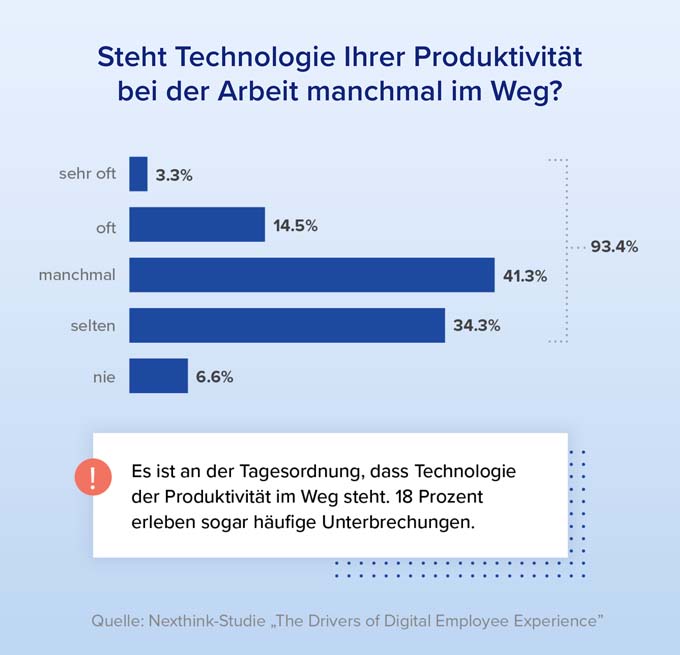Digital workplace: What the biggest brakes on productivity are
A study has examined what most limits productivity in a digital workplace. According to the study, the biggest sources of frustration are connectivity issues, application performance, distractions from colleagues, and the requirement to shut yourself off for focused work - the latter of which leads more than half of employees to do their work in a home office.

A digital workplace is now largely standard. But the more technology, the greater the annoyance. The software manufacturer Nexthink has now presented the results of its latest report, "The Drivers of Digital Employee Experience (DEX)". The report examines the disruptions and problems employees face in the IT experience. It became clear that it is mostly IT and colleagues that cause frustrating interruptions in the workflow.
Digital workplace and human distractions
Ninety-three percent of more than 1,000 workers said technology in the workplace interferes with productivity in one way or another. The most commonly cited "technology problem" that disrupts productivity and focused work is "human distractions." This is the reason to get work done at home (according to 55 percent of respondents who said there is too little room for focused work), or to shut yourself off for focused work, such as turning off your phone or entering mock meetings (33 percent said they use this digital self-defense).
"What we've found over the years through our research and individual experience is that technology is often both the solution and the problem," said Yassine Zaied, Chief Strategy & Marketing Officer, Nexthink. "The question organizations should be asking is how IT teams can solve these common problems while balancing the needs of individual teams with the legitimate interests of the business. Technology is our greatest asset, but a true understanding of its weaknesses and potential is critical to ensuring positive digital experiences for employees."
Technology is not everything
The aforementioned report explored frustrations using a survey of more than 1,000 respondents, 20 individual interviews and 86 diary entries from a subset of employees documenting their issues with technology. The research also found that only half of the respondents felt that technology was a key enabler of greater efficiency. Of the disruptions cited, connectivity and application performance were the biggest technology obstacles, and these complaints were cited equally by home office and office-based employees. Even short disruptions (under five minutes and between five and 10 minutes) lead to high rates of employee frustration, according to the diary entries - an uphill battle for IT to gain the trust and appreciation of employees. When asked why employees are hesitant to contact the IT department with a problem, the four most common answers were:
- Fear of a lengthy support process
- Uncertainty whether the technical problem only affects them or whether it could also be a fault of their own
- Fear that the problem is too minor, despite the frustration it causes
- Assumption that the IT department can't help anyway.
Unsurprisingly, the report finds that the better technology supports their productivity, the happier employees were.

Previous studies have shown that 20 percent of employees would leave their jobs because of a poor IT experience. Since technology and how it is experienced are critical to productivity as well as overall employee satisfaction and return on investment, it is essential for IT departments to focus here, according to one finding of this study.
Source: Nexthink









